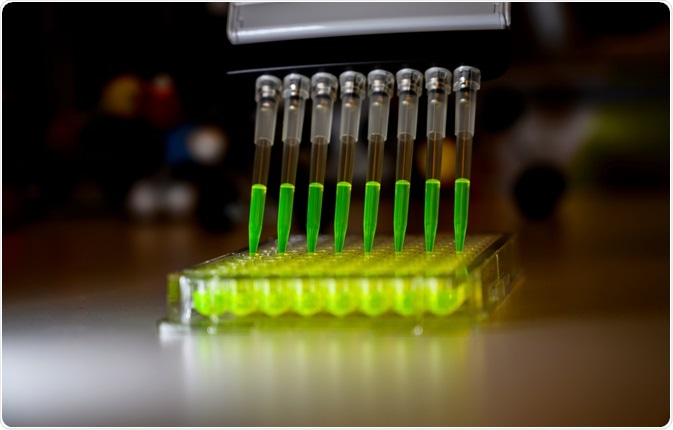What is Confocal Fluorescence Microscopy?
Confocal fluorescence microscopy is a commonly used optical imaging method in biology, combining fluorescence imaging with confocal microscopy for increased optical resolution. This article will discuss the principles of fluorescence and confocal microscopes, and describe the stages of fluorophore selection and sample preparation.
.jpg) Image Credit: Micha Weber / Shutterstock.com
Image Credit: Micha Weber / Shutterstock.com
What is fluorescence?
Fluorescence is the process by which a photon is absorbed, and another of slightly lower energy, and therefore longer wavelength, is subsequently emitted. Under normal circumstances, the electrons of a fluorophore (a molecule capable of fluorescence) are in a low-energy ground state, which when excited by interaction with an incident photon may be promoted to a higher energy level.
Some energy is thought to be consumed by non-radiative decay processes, and the difference in energy between the incident and emitted photon is known as Stokes shift. As the system relaxes vibrationally the electron returns to the ground state, releasing the remaining difference between the electron energy levels as a photon. The decay rate generally follows first-order kinetics, with most commonly employed fluorophores emitting within nanoseconds.
Many naturally occurring compounds are intrinsically fluorescent, and a vast library of additional specially engineered fluorophores is in constant development. Organic fluorophores frequently contain a number of double bonds and polyaromatic structures that provide delocalized electrons throughout the molecule, which are then capable of excitation.
In practical application, fluorophores are selected by the desired excitation and emission wavelengths, the intensity of returned light (quantum yield), and the fluorescence time. Other considerations that may encourage the use of a particular fluorophore over another include the molecular weight, as larger molecules may be sterically hindered in some applications, the presence of other fluorophores that may provide overlapping signals, and the specificity of the fluorescent label.
Molecular “lock and key” mechanisms can be exploited to ensure that fluorophores bond with structures of interest, potentially only activating or deactivating once in position. Antibodies form highly specific bonds with their target structure and are frequently linked to fluorophores in order to track the number and distribution of the target in situ. More recently, peptide and nucleic acid sequences have been employed to similar effect in identifying cellular components.
What is confocal microscopy?
In confocal microscopy a laser beam is focused to a specific depth within a sample, and similarly to ordinary light microscopes, any reflected or emitted light is detected by a properly positioned microscope.
Unwanted visual noise from the sample, besides light from the spot in focus with the laser, is omitted from the final image by the use of a pinhole aperture that prevents light scattered from higher angles from passing through. The pinhole is placed along the same plane as the sample to ensure that only photons traveling in a direct line from the sample to the microscope are detected. This is said to be in a conjugate focal plane, hence the portmanteau “confocal”.
The image captured is generally in the range of several hundred nanometers, and so large samples are scanned to allow a larger image to be stitched together later. Adjusting the focal point of the laser and microscope along each of the three axes allows scientists to build up a three-dimensional image of the sample of interest.
Depending on the transparency of the sample, and the wavelength of exciting light, samples can be imaged to a depth of a few hundred micrometers. Maintained scanning over a period of time provides time-lapsed images that allow scientists to observe the dynamics of tagged molecules or structures over time.
The laser utilized in confocal microscopy, besides illuminating a small section of the sample, can instead be used to excite fluorophores, massively improving the sensitivity of detection and signal-to-noise ratio when compared with reflected light from the sample alone.
Additionally, significantly lower intensities of laser light may be employed to obtain a sufficient signal, reducing the risks to the sample associated with photon bombardment. Other sub-types of confocal microscope are available, depending on the application, which limits exposure to photons and improves the collection time of images by using a slit or spinning disc in place of a pinhole.
However, the availability and diversity of laser types accommodated by laser scanning confocal microscopy mean that it remains the most popular option.
 Image Credit: souvikonline200521 / Shutterstock.com
Image Credit: souvikonline200521 / Shutterstock.com
How are samples prepared for confocal fluorescence microscopy?
As discussed, fluorophores are selected for compatibility with the sample under investigation and favorable spectral properties. The great sensitivity of fluorescent probes means that only a comparatively small number need be present in the sample to achieve a sufficient signal.
Over- or under-populating a sample with fluorophores can be disadvantageous, generating a noisy signal or incomplete structural elucidation, and so care must be taken in selecting an appropriate concentration.
The repeated activation of fluorophores eventually induces a phenomenon known as photobleaching, leaving the molecule completely unable to fluoresce. In time-sensitive studies, this must be accounted for, as the number of emitted photons will decline following repeated bouts of excitation.
Samples frequently undergo fixation before microscopy to carefully preserve the structural features of the sample. Formaldehyde has historically been used for this purpose, rapidly penetrating cell membranes and forming disulfide bridges between cysteine residues in proteins, preserving even the fine structural details of antigen sites.
In cases where proteins need not be preserved, when examining the presence of small molecules for example, alcohol fixation at low temperatures may instead be used. In order to ensure complete penetration of the fixation agent, the cells are exposed to mild detergents, increasing the permeability of the cell membrane.
Antibodies are the most common targeting agent in fluorescent labeling due to their versatility and specificity. Specificity can be improved further by a process known as blocking, flooding the sample with a protein cocktail that occupies non-specific binding sites and exhausts the protein-crosslinking ability of any remaining formaldehyde.
Following each of these steps, the primary or secondary antibody linked fluorophore can be added. In some cases, additional counter stains may be included to reduce background fluorescence.
Fixation, by definition, is unsuitable in dynamic microscopy applications that intend to observe the function of the cell or tissue over time. Live-cell imaging raises a number of issues with regards to keeping appropriate cell conditions within the whole microscopy chamber, including temperature, atmospheric composition of CO2 and humidity, and the pH and contents of the cell culture medium.
Small fluctuations in temperature can cause issues with focusing the laser and microscope due to changes in the refractive index of the material, and constant evaporation from the cell culture flask only exacerbates this problem.
Sources
Sanderson, M. J., Smith, I., Parker, I. & Bootman, M. D. (2016) Fluorescence Microscopy. Cold Spring Harbor Protocols, 10. doi: 10.1101/pdb.top071795 https://www.ncbi.nlm.nih.gov/pmc/articles/PMC4711767/
Nwaneshiudu, A., Kuschal, C., Sakamoto, F. H., Anderson, R. R., Schwarzenberger, K. & Young, R. C. (2012) Introduction to confocal microscopy. Journal of Investigative Dermatology, 123(12), pp.1-5. ohsu.pure.elsevier.com/…/introduction-to-confocal-microscopy
Lavrentovich, O. D. (2012) Confocal Fluorescence Microscopy. Optical Imaging and Spectroscopy. doi: 10.1002/0471266965 https://onlinelibrary.wiley.com/doi/full/10.1002/0471266965.com127
Croix, C. M., Shand, S. H. & Watkins, S. C. (2018) Confocal microscopy: comparisons, applications, and problems. BioTechniques, 39(6S). doi: 10.2144/000112089 https://www.future-science.com/doi/full/10.2144/000112089
Smith, C. L. (2011). Basic Confocal Microscopy. Current Protocols in Neuroscience. doi: 10.1002/0471142301.ns0202s56 currentprotocols.onlinelibrary.wiley.com/…/0471142727.mb1411s81
Further Reading
- All Fluorescence Microscopy Content
- How do Epifluorescence Microscopes Work?
- GFP-tagging in Fluorescence Microscopy
- Advances in Fluorescence Microscopy
- Wide-field Fluorescence Microscopy
Last Updated: Jan 22, 2021

Written by
Michael Greenwood
Michael graduated from Manchester Metropolitan University with a B.Sc. in Chemistry in 2014, where he majored in organic, inorganic, physical and analytical chemistry. He is currently completing a Ph.D. on the design and production of gold nanoparticles able to act as multimodal anticancer agents, being both drug delivery platforms and radiation dose enhancers.
Source: Read Full Article
